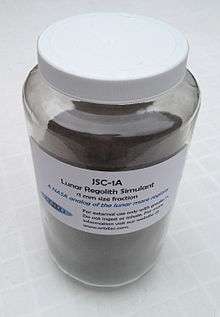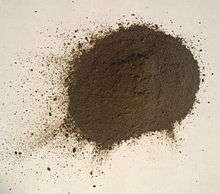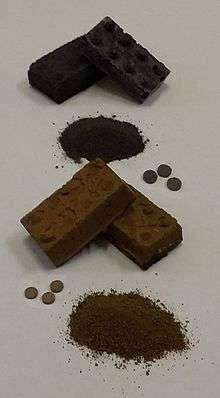Lunar regolith simulant



A lunar regolith simulant is a terrestrial material synthesized in order to approximate the chemical, mechanical, and engineering properties of, and the mineralogy and particle size distributions of, lunar regolith.[1] Lunar regolith simulants are used by researchers who wish to research the materials handling, excavation, transportation, and uses of lunar regolith. Samples of actual lunar regolith are too scarce, and too small, for such research.
MLS-1
MLS-1 (Minnesota Lunar Simulant 1) is a lunar simulant that was developed at the University of Minnesota. The basaltic rock used in this simulant was mined from a quarry in Duluth, Minnesota. It contains plagioclase, olivine, pyroxene and ilmenite as some of its major minerals. The minerals and grain sizes resemble the chemistry of the Apollo 11 mare material (specifically soil sample 10084).[2]
JSC-1
JSC-1 (Johnson Space Center Number One) is a lunar regolith simulant that was developed in 1994 under the auspices of NASA and the Johnson Space Center. Its developers intended it to approximate the lunar soil of the maria. Unlike MLS-1, it simulates a soil that is poor in titanium. It is a basaltic ash with a high glass content.[1]
Toutanji et al. used JSC-1 to create a sulphur-based Lunarcrete simulant.[3]
JSC-1A
In 2005, NASA contracted with Orbital Technologies Corporation (ORBITEC) for a second batch of simulant in three grades:[4]
- JSC-1AF, fine, 27 µm average size
- JSC-1A, a reproduction of JSC 1, less than 1 mm size
- JSC-1AC, coarse, a distribution of sizes < 5 mm
NASA received 14 metric tons of JSC-1A, and one ton each of AF and AC in 2006. Another 15 tons of JSC-1A and 100 kg of JSC-1F were produced by ORBITEC for commercial sale.[5] An 8-ton sand box of commercial JSC‐1A is available for daily rental from the California Space Authority.
JSC-1A can geopolymerize in an alkaline solutions resulting in a hard, rock-like, material.[6][7] Tests show that the maximum compressive and flexural strength of the 'lunar' geopolymer is comparable to that of conventional cements.[7]

FJS-1
FJS-1 (Fuji Japanese Simulant 1) was developed in Japan from Mount Fuji area basalts. The grain size and mineralogy of these basalts simulate well the samples from the Apollo 14 mission.
FJS-2
FJS-2 is similar to FJS-1 however olivine was added to change the composition slightly. FJS-2 is a better Apollo 14 simulant than FJS-1.
FJS-3
FJS-3 is composed of the root simulant, FJS-1, with added olivine and ilmenite. FJS-3 is a good simulant for Apollo 11 samples.[8]
Other simulants
Other simulants include:[9][10]
- MKS-1
- CAS-1[11]
- CMU-1
- NAO-1
- NU-LHT
- NU-LHT-1M
- NU-LHT-2M
- NU-LHT-2C
- NU-LHT-1D
- OB-1
- Chenobi
- GRC-1
- BP-1
- ALS
- CSM-CL
- SC-1
- CUG-1
- Oshima Base Simulant
- Kohyama Base Simulant
See also
References
- 1 2 David S. McKay; James L. Carter; Walter W. Boles; Carlton C. Allen & Judith H. Allton (1994). "JSC-1: A new lunar soil simulant" (PDF). In Rodney G. Galloway & Stanley Lokaj. Engineering, Construction, and Operations in Space IV; Proceedings of the 4th International Conference, Albuquerque, New Mexico, February 26–March 3, 1994. 2. New York: American Society of Civil Engineers. pp. 857–866. ISBN 0872629376.
- ↑ Batiste, S.N., Sture, S., 2005. Lunar Regolith simulant MLS-1: production and engineering properties. Abstract, Lunar regolith simulant materials workshop, Marshal Space Flight Center.
- ↑ H. Toutanji; M. R. Fiske & M. P. Bodiford (2006). "Development and Application of Lunar "Concrete" for Habitats". In Ramesh B. Malla; Wiesław Binienda & Arup K. Maji. Proceedings of 10th Biennial International Conference on Engineering, Construction, and Operations in Challenging Environments (Earth & Space 2006) and 2nd NASA/ARO/ASCE Workshop on Granular Materials in Lunar and Martian Exploration held in League City/Houston, TX, during March 5–8, 2006. Reston, VA: American Society of Civil Engineers. pp. 1–8. doi:10.1061/40830(188)69). ISBN 0784408300.
- ↑ http://isru.msfc.nasa.gov/lib/workshops/2009/03_JSC-1A_Lunar_RegSimulant_Update_BGustafson.pdf
- ↑ Orbital Technologies Corporation - Online Store for Lunar and Mars Soil Simulant
- ↑ Montes, Broussard, Gongre, Simicevic, Mejia, Tham, Allouche, Davis; Evaluation of lunar regolith geopolymer binder as a radioactive shielding material for space exploration applications, Adv. Space Res. 56:1212–1221 (2015)
- 1 2 3 Alexiadis, Alberini, Meyer; Geopolymers from lunar and Martian soil simulants, Adv. Space Res. (2016), doi:10.1016/j.asr.2016.10.003
- ↑ Kanamori, Hiroshi; Satoru Udagawa; Tetsuji Yoshida; Shinji Matsumoto; Kenji Takagi (1998). "Properties of Lunar Soil Simulant Manufactured in Japan". Proceedings of the international symposium on space 98, ASCE, Reston, Va.: 462–468.
- ↑ http://www.lpi.usra.edu/leag/reports/SIM_SATReport2010.pdf
- ↑ http://www.chemenv.titech.ac.jp/watanabe/Media/PDF-conf/Earth%26Space08.pdf
- ↑ Yongchun Zheng; Shijie Wang; Chunlai Li; Ziyuan Ouyang; Junming Feng; Jianzhong Liu & Yongliao Zou (2005). "The Development of CAS-1 Lunar Soil Simulant" (PDF). International Lunar Conference #7, September 18–23, 2005. Toronto, Ontario, Canada.
Further reading
- Bonnie Cooper (2007). "Appendix C: Lunar soil simulants". In David G. Schrunk; Burton L. Sharpe; Bonnie L. Cooper; Madhu Thangavelu. The Moon: resources, future development, and settlement (2nd ed.). Springer. pp. 257–268. ISBN 9780387360553.
- P Carpenter, L Sibille, S Wilson and G Meeker (2006). "Development of Standardized Lunar Regolith Simulant Materials". Microscopy and Microanalysis. 12 (Suppl. 02): 886–887. Bibcode:2006MiMic..12..886C. doi:10.1017/S143192760606301X.
- D. S. McKay; J. L. Carter; W. W. Boles; C. C. Allen & J. H. Alton (1993). "JSC-1: A new lunar regolith simulant". Lunar and Planetary Science XXIV. pp. 963–964.
- J. Ledlie Klosky; Stein Sture; Hon-Yim Ko & Frank Barnes (1996). "Mechanical Properties of JSC-1 Lunar Regolith Simulant". In Stewart W. Johnson. Engineering, Construction, and Operations in Space 5: Proceedings of the Fifth International Conference on Space ’96 held in Albuquerque, New Mexico, June 1–6, 1996. New York: American Society of Civil Engineers. pp. 680–688. doi:10.1061/40177(207)94). ISBN 0784401772.
- Yongchun Zheng, Shijie Wang, Ziyuan Ouyang, Yongliao Zou, Jianzhong Liu, Chunlai Li, Xiongyao Lia and Junming Feng (2009-02-02). "CAS-1 lunar soil simulant". Advances in Space Research. 43 (3): 448–454. Bibcode:2009AdSpR..43..448Z. doi:10.1016/j.asr.2008.07.006. — also: